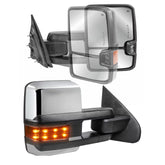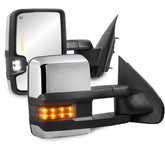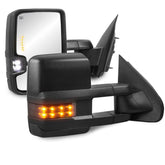How to Determine Towing Capacity
Have you ever found yourself unsure about how much weight your vehicle can safely tow? Whether you haul a camper, boat, or heavy equipment, accurate towing capacity will help you protect vital drivetrain and suspension components.
Ready to tackle your towing needs with confidence? Let’s explore how to determine towing capacity and make every haul a safe and successful one.
Towing Terminology
Before hauling, the first thing is to understand a few key terms
Gross Vehicle Weight Rating (GVWR)
The Gross Vehicle Weight Rating (GVWR) represents the maximum total weight that your vehicle can safely carry, including the weight of the vehicle itself (curb weight), passengers, cargo, and any additional equipment or accessories.
The GVWR is a fixed number determined by the vehicle manufacturer, and the total weight of your vehicle does not exceed this limit.
For instance, you can find the GVWR on a sticker located on the door jam of your vehicle. If your GVWR is listed as 7,050 pounds, this means that the total weight of your vehicle, including everything inside it, should not exceed this number.
Gross Axle Weight Rating (GAWR)
The Gross Axle Weight Rating (GAWR) refers to the maximum weight that can be supported by a single axle, either front or rear.
Overloading an axle beyond its GAWR can result in axle damage, uneven tire wear, and compromised vehicle stability.
On your vehicle's door jamb sticker, you'll typically find both the front and rear GAWRs listed. For example, the front GAWR might be 3,525 pounds, while the rear GAWR could be 3,800 pounds. It's essential to distribute the weight of passengers and cargo evenly to avoid overloading either axle.
Gross Combined Weight Rating (GCWR)
The GCWR represents the maximum allowable weight of your vehicle and everything in it, plus anything you are towing, such as a trailer. Essentially, it is the sum of the vehicle's GVWR and the weight of the trailer.
For example, if your vehicle's GCWR is 16,200 pounds and your vehicle's curb weight is 5,500 pounds, this means you can safely tow up to 10,700 pounds, assuming your vehicle is empty. However, it's important to note that if your vehicle is loaded with passengers and cargo, the maximum trailer weight you can tow decreases accordingly.
Curb Weight
Curb weight refers to the weight of the vehicle as it comes from the dealership, including all standard equipment, fluids, and a full tank of gas, but without any passengers, cargo, or optional accessories. This is the "bare" weight of the vehicle.
Payload Rating
The payload rating is the maximum weight of all the cargo, passengers, and additional equipment you can add to the vehicle. This number is calculated by subtracting the curb weight from the GVWR. For example, if your vehicle's GVWR is 7,050 pounds and the curb weight is 5,186 pounds, your payload rating would be 1,864 pounds. This means you can safely add up to 1,864 pounds of passengers, cargo, and equipment to your vehicle.
Tongue Weight
The amount of weight is supported by the coupling between the truck and the trailer. It is the downward force that the tongue of the trailer exerts on the hitch of the towing vehicle. It usually represents 10-15% of the total loaded trailer weight.
How to Determine
Now that you have this information, we'll walk you through determining your truck's towing capacity. Read on!
Step 1: Determine basic vehicle information
The first thing you need to do is to find your vehicle's detailed specifications and weight ratings. They are on your owner's manual or door jamb sticker and include the Gross Vehicle Weight Rating (GVWR), Gross Axle Weight Rating (GAWR), Gross Combination Weight Rating (GCWR), and maximum towing capacity. This information is determined by your vehicle's make, model, engine, and configuration.
Step 2: Calculate the Vehicle’s Towing Capacity
There are two general scenarios when calculating towing capacity. You can find the towing capacity listed directly in your owner's manual or on the driver's door jamb. If the exact towing capacity is not listed, you will need to calculate it yourself. You can subtract the vehicle's curb weight (the weight of the vehicle without passengers and cargo) from the GCWR. The difference is the maximum weight of the trailer you can safely tow. Here's the formula:
Towing Capacity = GCWR - Curb Weight
For example, if your vehicle has a GCWR of 15,000 pounds and a curb weight of 5,500 pounds, your towing capacity is 9,500 pounds.
Note:
The towing capacity of the above example vehicle assumes the vehicle is empty. If you have passengers, cargo, or other accessories, this will reduce the weight you can safely tow. You must subtract the weight of the passengers and cargo from the calculated towing capacity.
Step 3: Check the Tongue Weight
Another important factor in safe towing is tongue weight. The ideal tongue weight is not a fixed value, but rather a percentage of the overall weight of your trailer and its payload. For example, if you’re towing a trailer that weighs 5,000 pounds, the tongue weight should be approximately 500-750 pounds.
Anything below or over that number can result in unsafe handling while towing. Make sure the load is evenly distributed on the trailer to avoid exceeding the tongue weight capacity, which could lead to steering problems or trailer sway.
You also need to know
The Hitch Rating
Your towing setup is only as strong as your vehicle’s hitch receiver. It is rated for the weight you intend to tow. Hitches come in different classes:
-
Light-duty, suitable for small trailers or bike racks, usually up to 2,000 pounds.
-
Moderate-duty can handle up to 3,500 pounds.
-
Heavy-duty, designed for larger trailers and campers, typically up to 5,000 pounds.
-
Extra heavy-duty, for towing, weighs between 10,000 to 20,000 pounds or more, depending on the hitch.
Note: If your hitch isn’t rated for the trailer you plan to tow, you will need to upgrade it to one that can handle the load.
Additional Towing Equipment
-
Brake Controller: If your trailer is equipped with electric brakes, you will need a brake controller installed in your vehicle to activate the trailer’s brakes in sync with your vehicle’s brakes.
-
Weight Distribution Hitch: If your trailer weight exceeds 5,000 pounds or the tongue weight is more than 10-15% of the trailer’s weight, a weight distribution hitch may be necessary to distribute the load more evenly across your vehicle and trailer.
-
Sway Control: For larger trailers, consider using a sway control device to prevent trailer sway, especially in windy conditions or during high-speed driving.
Perform a Test Run
Before hitting the road with a full load, perform a test run to ensure everything is set up correctly. Check the following:
-
Brake Response: Test the brakes at low speeds to ensure they respond properly and stop the vehicle-trailer combination safely.
-
Trailer Connection: Verify that the trailer is securely connected, with safety chains and lights functioning correctly.
-
Weight Distribution: Make sure the weight is evenly distributed on the trailer, and the tongue weight is within the appropriate range.
-
Mirrors and Visibility: Ensure that your mirrors provide a clear view of the trailer and surrounding traffic.
Conclusion
By following the steps outlined above, you can ensure that you tow safely and within the limits of your vehicle’s capabilities. If you have any questions about towing accessories such as suspension upgrades, chat with our expert team.
Featured Products
- $398.99
$419.99- $398.99
- Unit price
- / per
- $205.99
- $205.99
- Unit price
- / per
- $198.99
- $198.99
- Unit price
- / per
- $235.99
- $235.99
- Unit price
- / per














